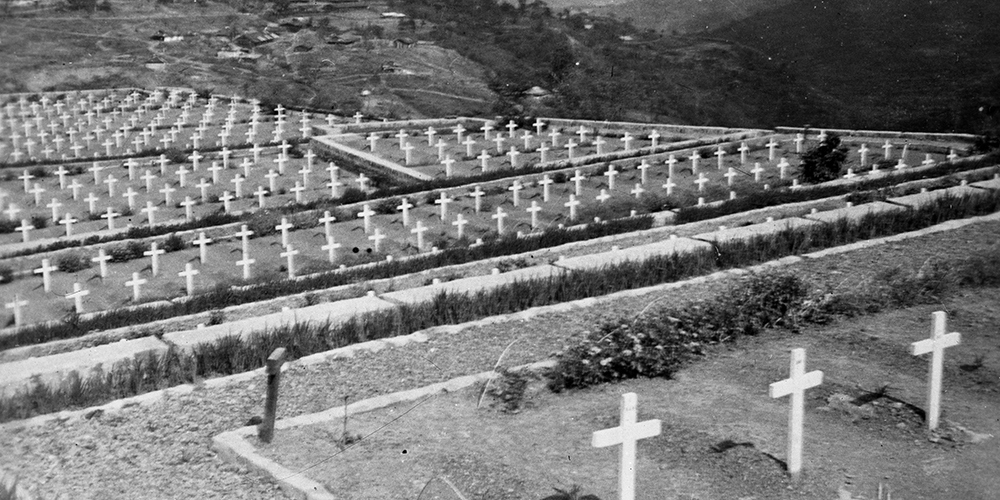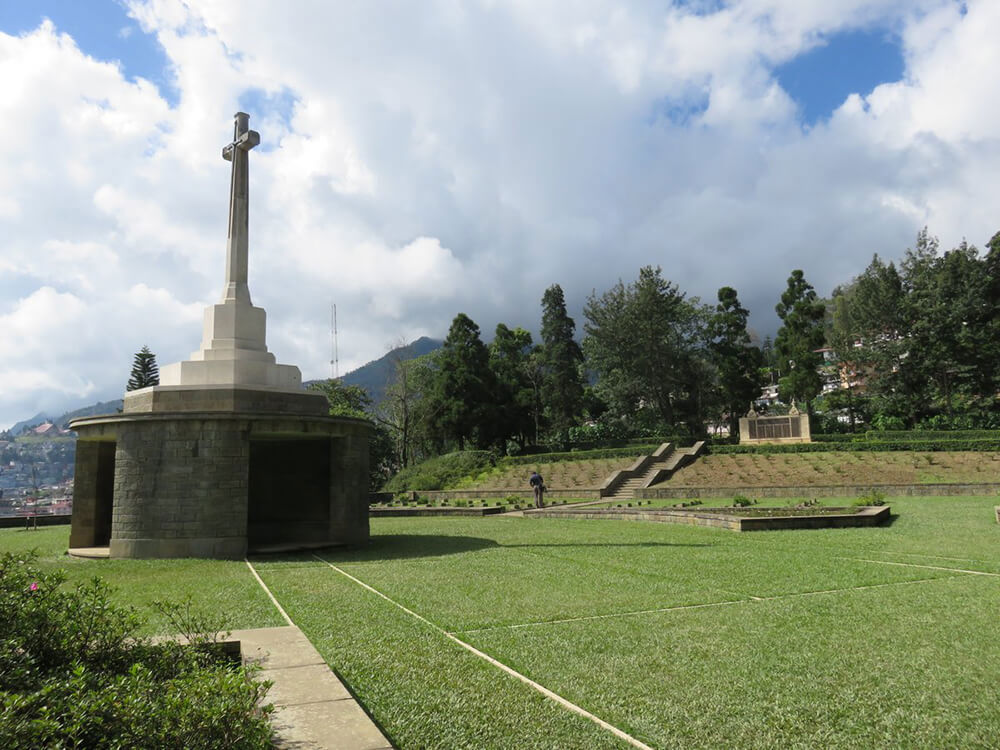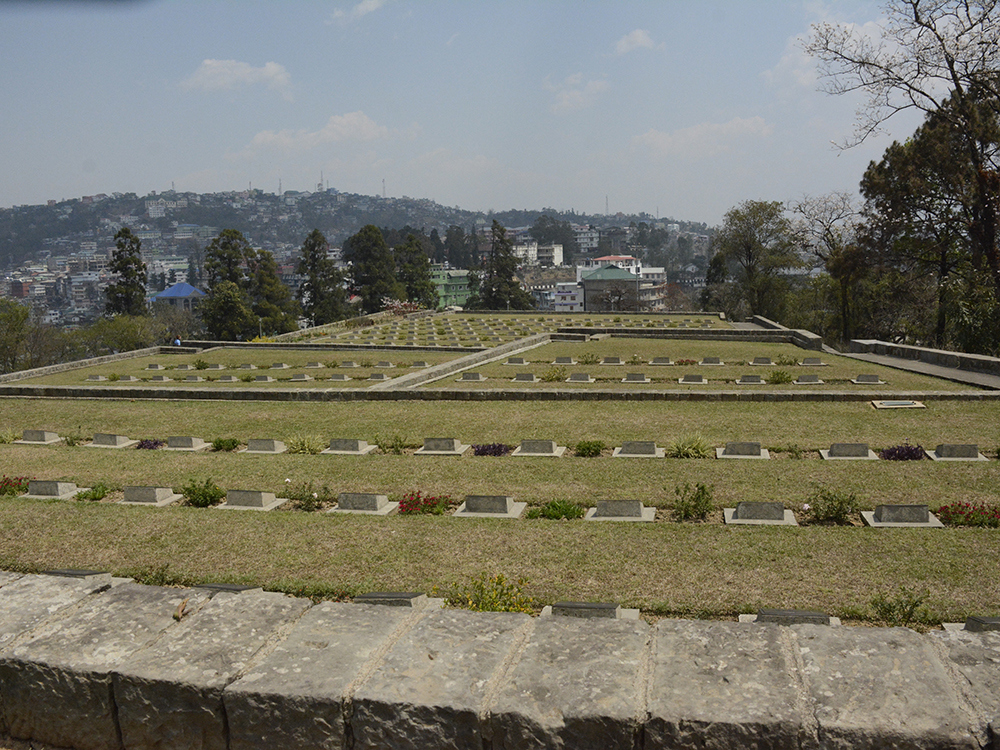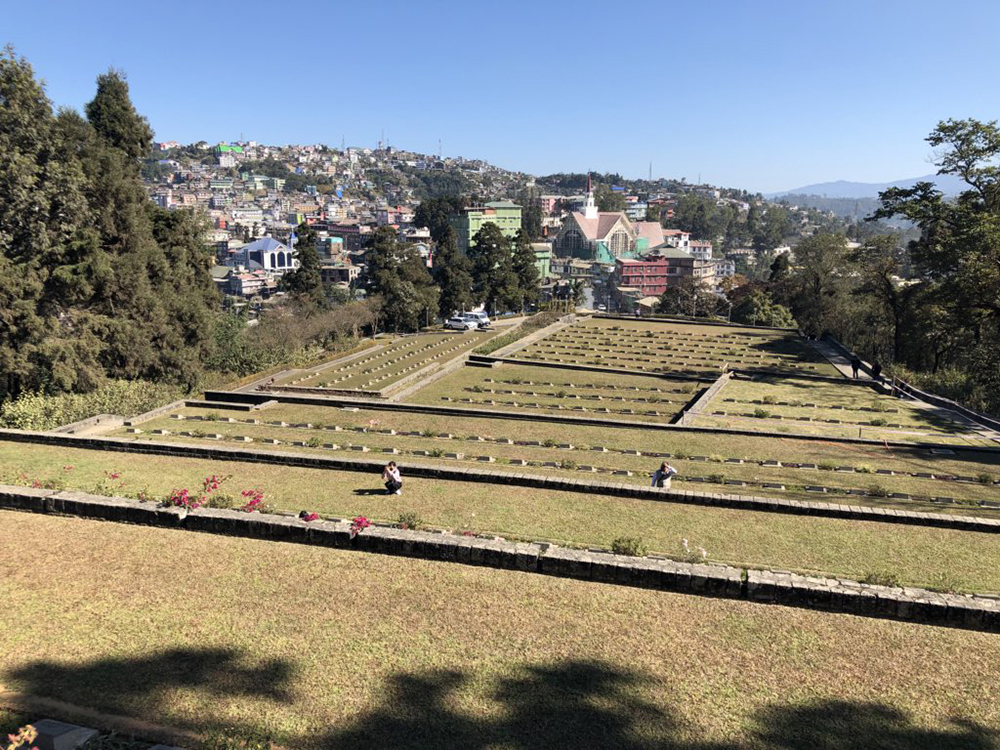03 April 2023
Lasting Tribute to Fallen Soldiers: Kohima War Cemetery
4 April 1944 saw the start of one of the key battles of the war in Asia. Discover more about the Battle of Kohima and the commemoration of those buried at Kohima war cemetery.

India’s involvement in WW2
With 2.5 million men, the Indian Army of the Second World War was the largest volunteer army in history. Indians served in theatres of war across the world: India and Burma; Malaysia, Singapore and Hong Kong; the Middle East and North Africa; Greece and Italy. They served at sea and in the air, as well as contributing to support and medical care.
Indians took part in the struggle between Allied and Axis forces in the deserts of North Africa, including the crucial Battle of El Alamein in October 1942, followed by the pursuit of enemy forces into Libya and Tunisia in early 1943. They also fought in East Africa, including the actions around Keren in Eritrea.

Image: Commonwealth forces in North Africa © IWM (E 2502)
Three Indian Army divisions fought in Italy between 1943 and 1945, forming around half of the Commonwealth force. They led the assault on the German defensive lines, including the Battle of Monte Cassino and the pursuit of German forces northwards.
When Japanese forces invaded the Malay Peninsula in December 1941, Indian troops had already been sent to reinforce the local defences. After the fall of Singapore in February 1942, some 65,000 Indian soldiers were taken prisoner of war. The Indian Army would later play a vital role in halting the Japanese advance at the iconic battles of Kohima and Imphal in the north-east of India in 1944.
The CWGC commemorates more than 87,000 people who lost their lives while serving with Indian forces during the Second World War.
How many Commonwealth war graves are in India?
More than 62,000 casualties of the world wars are commemorated by the CWGC in India, commemorated on memorials and buried in cemeteries across the country.
Nearly 20,000 of the casualties we commemorate in India date from World War One. 13,000 of these are commemorated on the Delhi Memorial (India Gate) which also stands as a national memorial to all soldiers of Undivided India who died between 1914 and 1921.
Another 43,000 World War Two casualties are commemorated at our sites in India. The vast majority Indian are servicemen commemorated on the Delhi/Karachi 1939-1945 Memorial and the Bombay/Chittagong 1939-1945 Memorial.
Just over 7,000 United Kingdom war dead of the Second World War are commemorated in India, as well as smaller numbers of casualties from our other member nations; Canada, Australia, New Zealand and South Africa.
The battle of Kohima
The main Axis power in South-East Asia was Japan, which had been attacking European colonial outposts in the region. After the attack on Pearl Harbour in December 1941, the campaign intensified as the Japanese launched the invasion of Burma (Myanmar), at that time a British possession.
The campaign was swift and ruthless. The capital, Rangoon, fell in early March 1942, and by May, the British had been driven out of the country. The Allies, wary of an attack from Burma into India, occupied Imphal, a strong position that would defend against incursions through the Naga Hills.
Owing to the limited time for operations outside of the rainy season, and aware of the cost that attacking Imphal would incur, the Japanese for paused there.
By 1943, the tide was beginning to turn the other way, and the Japanese were concerned about an Allied counterattack in Burma. To pre-empt this, the Japanese embarked on the U-Go Offensive to capture Imphal and push into northern India.
The capture of Kohima was an integral part of the attack on Imphal. Doing so would cut the Allies’ supply lines and threaten the important supply stores at Dimapur. Kohima itself was lightly defended, with most Allied troops in the region split between Imphal and Dimapur. When the attack came the Japanese vastly outnumbered the Allied defenders.
The fighting began in earnest on 4 April 1943 with localised fighting on the hills around the town. As the battle escalated, most of the fighting became concentrated on Garrison Hill, especially in and around the compound that was home to the Deputy Commissioner for the region.
The Allied forces were effectively placed under siege, surrounded on all sides and under almost constant bombardment. During the fiercest of the fighting, it was concentrated around the tennis court in the compound’s gardens, which became something of a no-man’s land - subsequently giving the battle the nickname the ‘Battle of the Tennis Court’.
Allied reinforcements slowly began to arrive and the tide of battle slowly began to turn, but it wasn’t until 18 April that a full counter-attack was launched and Allied troops were able to break through and relieve those surrounded on Garrison Hill.
The counterattack was a long and arduous process. The terrain and weather meant that tanks and vehicles couldn’t be brought into the fight, and the Japanese forces dug in and ferociously defended their positions.
One of the last areas to be reclaimed was the famous tennis court on Garrison Hill, which was eventually recaptured on 11 May, the previously picturesque hillside now a devastated wasteland. With the tide of battle now firmly against them, the Japanese ordered a retreat on 31 May.
The battle is seen as something of a turning point for the war in the Pacific, compared by many to the Siege at Stalingrad where a smaller force persevered despite overwhelming odds. Earl Mountbatten, Viceroy of India, described it as ‘probably one of the greatest battles in history…in effect, it was the British-Indian Thermopylae’.
Kohima war dead: Remembering the fallen
 Such was the importance of the Battle of Kohima, and the magnitude of the sacrifice made by those who fought there, that there are a number of non-CWGC memorials in the region to the casualties of the battle of Kohima.
Such was the importance of the Battle of Kohima, and the magnitude of the sacrifice made by those who fought there, that there are a number of non-CWGC memorials in the region to the casualties of the battle of Kohima.
The most famous is the memorial to the 2nd British Division - a 15 feet tall monolith made of local stone - which bears the famous words now known as the Kohima Epitaph:
When you go home,
tell them of us and say,
For Their tomorrow,
We gave Our today
The memorial stands on the battlefield, in what is now the Kohima War Cemetery. No exact construction date is known, but it was erected between the end of the fighting in 1944 and April 1946.
Outside of the cemetery stand a number of other memorials for regiments and units that fought at Kohima during the war, including the 4th Battalion Punjab Regiment memorial, the Royal Scots Memorial, a memorial to the Durham Light Infantry and a collection of memorials to the 3rd Assam Rifles and the Assam Regiment.
Also found at Kohima is the shell of a Lee Grant Tank that fought in the battle and remains as a memorial to the 2nd Infantry Division.
You can find the records of all the casualties commemorated at Kohima by using our Find War Dead tool.
History and significance of Kohima war cemetery
Kohima War Cemetery remains one of our most visually arresting sites anywhere in the world.
The site was once the home to the Deputy Commissioner to the region, but was turned to a devastated battlefield as Commonwealth forces fought a desperate defence, ultimately stopping the Japanese attack.
The men that fell there were buried where they fought, grouped roughly into religious groups and marked with temporary wooden crosses or plain markers. The terraces of the site were re-established, creating plots within the cemetery and creating an incredible panoramic view from the cemetery over the town of Kohima.
By the end of the war, the cemetery contained approximately 1,200 burials and was close to capacity.
The architect Colin St Clair Oakes, who had fought in Burma during the war and who had worked as an architect in India was appointed as the Commission’s Senior Architect for India, Burma and South-East Asia in November 1945, later becoming Principal Architect to the Commission for India and South-East Asia District.
Oakes incorporated several factors that make Kohima War Cemetery unique, but none more so than the recreation of the old tennis court. The court, which was the epicentre of the battle, was destroyed during the action, but was recreated in moulded concrete as an evocative, physical reminder of the battle.
The Cross of Sacrifice, a familiar feature of CWGC cemeteries, in Kohima is unique in and of itself. Located on the old tennis court that was at the very heart of the battle, the cross stands atop a shelter building, providing vital shade from the midday sun and shelter from the monsoon rains.
An inscription within the shelter reads:
‘HERE AROUND THE TENNIS COURT OF THE DEPUTY COMMISSIONER LIE MEN WHO FOUGHT IN THE BATTLE OF KOHIMA IN WHICH THEY AND THEIR COMRADES FINALLY HALTED THE INVASION OF INDIA BY THE FORCES OF JAPAN IN APRIL 1944’
How many soldiers are laid to rest at Kohima war cemetery?
Today, more than 1,400 Commonwealth war dead are buried at Kohima War Cemetery, of whom 1,275 are identified.
The majority of these casualties are Indian and United Kingdom war dead although a few members of the Royal Australian Air Force and Royal Canadian Air Force are also commemorated here.
A further 917 Hindu and Sikh soldiers who were cremated in accordance with their faith are commemorated on the Kohima Cremation Memorial which stands at the top of Kohima War Cemetery, looking down over the famous tennis court and the views down to the town below.

Visiting Kohima war cemetery - what you need to know
Kohima is the capital of the Nagaland state in north India, not far from the border with Myanmar.
If you’re planning on visiting, the nearby city of Dimapur has connecting flights to some of the bigger cities in India. From Dimapur, Kohima is then roughly a two hour drive.
The cemetery can be found in the centre of town and is open every day from 9am to 4pm.
How to find war graves in India
Indian forces played a vital role in both world wars and are commemorated in CWGC sites both in India and around the world.
You can use our website to discover more about how we commemorate our Indian war dead and plan a visit to our cemeteries and memorials across the globe. You’ll be able to find historical context and visitor information for our sites and find further details of the men and women we commemorate.
Want to discover more about the casualties we commemorate? Our How to Research guides are the perfect way to get started. We have a range of downloadable guides - including one to help you discover more about our Indian casualties.







